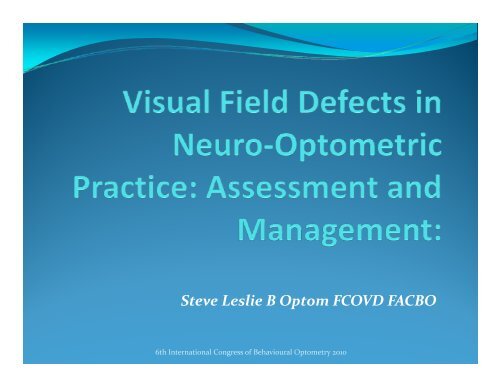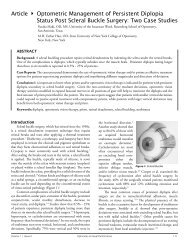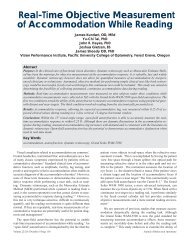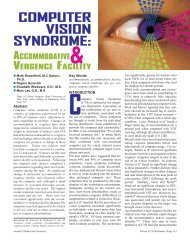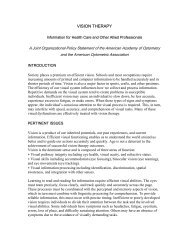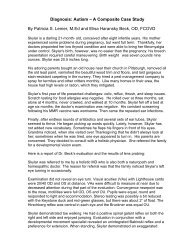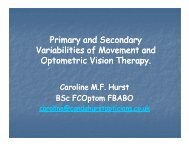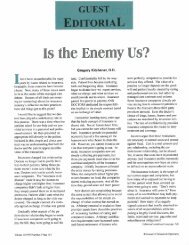Steve Leslie.pdf
Steve Leslie.pdf
Steve Leslie.pdf
Create successful ePaper yourself
Turn your PDF publications into a flip-book with our unique Google optimized e-Paper software.
<strong>Steve</strong> <strong>Leslie</strong> B Optom FCOVD FACBO<br />
6th International Congress of Behavioural Optometry 2010
Aetiology of visual field loss<br />
• Ocular pathology: glaucoma, optic nerve,......<br />
• Neurological conditions: MS,....<br />
• Stroke<br />
• Traumatic brain injury<br />
• One study found bilateral visual field deficits in at least 1<br />
in 7 of severe TBI patients*<br />
*Groswasser Z, Cohen M, Blankstein E. Polytrauma lt associated with traumatic ti brain<br />
injury: incidence, nature and impact on rehabilitation outcome. Brain Inj 1990;4:161.<br />
ICBO 2010
Anatomy<br />
• Field loss usually correlates well with visual pathway<br />
localised injury<br />
• Unilateral optic nerve lesion<br />
• Anterior chiasm<br />
• Chiasm<br />
• Bitemporal hemianopia and hemifield slide phenomenon<br />
ICBO 2010
ICBO 2010
Anatomy<br />
• Optic tract<br />
• Temporal lobe<br />
• 25% of postchiasmal<br />
pathology<br />
• Possible<br />
olfactory/gustatory<br />
hallucinations, seizures,<br />
aphasia (if dominant<br />
side involved)<br />
ICBO 2010
Parietal lobe<br />
• 35% of postchiasmal lesions<br />
• Field defects may be accompanied by agraphia,<br />
ipsilateralil lpursuit dysfunction<br />
• If right parietal area lesion, consider possibility of left<br />
neglect<br />
• Macula splitting more than sparing<br />
ICBO 2010
Occipital lobe<br />
• 80% infarct<br />
• Macular sparing<br />
• Often no other neurological company<br />
ICBO 2010
Effects on activities of daily living<br />
• Reading: effects of right or left hemianopia<br />
• Computer use<br />
• Driving<br />
• Balance issues<br />
• Walking<br />
• Television<br />
• Interference with rehabilitation<br />
ICBO 2010
Effects on rehabilitation progress<br />
and prognosis<br />
• Visual field loss has been found to be negatively<br />
correlated with return to work in a follow up study over<br />
15 years of Vietnam Veterans.<br />
GroswasserZ, Cohen M, Blankstein E. Polytrauma associated with traumatic brain injury: incidence,<br />
nature and impact on rehabilitation outcome. Brain Inj 1990;4:161.<br />
ICBO 2010
Severity of visual field loss<br />
(VFL)and health‐related quality of<br />
life<br />
• “Health related quality of life is diminished even in<br />
persons with relatively minor VFL”*<br />
• VFL causes difficulty with: ih<br />
• Driving<br />
• Dependency<br />
• Mental health<br />
• Distance vision<br />
• Peripheral vision<br />
*McKean‐Cowdin R et al. Am J Ophthalmol 2007;143:1013‐1023. (Doheny Eye Institute LA)<br />
ICBO 2010
Visual field loss affects ADLs ADL’s and<br />
rehabilitation progress<br />
• Awareness of visual field loss may help patients to<br />
adjust behaviour and performance of ADL’s<br />
• Other professionals may adjust therapies within the<br />
consideration of a visual field defect; communication<br />
is imperative.<br />
ICBO 2010
Assessment of visual fields<br />
• History, history, history<br />
• Bedside vs office assessment<br />
• Objective testing<br />
• Behaviourally assessed functional fields<br />
• Subjective fields<br />
ICBO 2010
Hierarchy of targets<br />
in quadrants<br />
• Hand motion<br />
• Finger motion<br />
• Finger counting /matching<br />
• Saccades to moving<br />
fingers/target (children,<br />
aphasia)<br />
• Color brightness<br />
comparison<br />
• Move single target across<br />
midlines, or present 4 red<br />
dots equidistant from<br />
central fixation (detects<br />
78% of chiasmal defects)<br />
ICBO 2010
Marking field loss midlines<br />
ICBO 2010
Macula sparing (striate lesion)<br />
vs splitting (3 ball technique)<br />
ICBO 2010
Amsler grid<br />
• Uesful for subtle central<br />
and paracentral<br />
scotomas which can<br />
often cause frustrating<br />
and difficult to diagnose<br />
symptoms of:<br />
• Ghosting<br />
• Blur<br />
• “Double vision”<br />
ICBO 2010
• Tangent screen<br />
• Static vs kinetic<br />
perimetry<br />
• Computerized<br />
functional visual field<br />
assessment<br />
• Computerised:REACT,<br />
C SDSST,SOSH, SEARCH,<br />
FASTREAD, INSPECT<br />
ICBO 2010
Focal and Ambient visual function<br />
• Many severe traumatic brain injuries involve the<br />
midbrain, where peripheral retinal input is<br />
integrated with ih proprioceptive i and vestibular<br />
information<br />
• “the ambient visual process must let you know<br />
where you are in space and essentially where you<br />
are looking before you process information about<br />
what you are looking at” (Padula & Argyris)<br />
ICBO 2010
Ambient disruption<br />
• Disruption of the ambient visual process disrupts<br />
the construct and stability of space so that the Z‐<br />
axis loses reference.<br />
• The disruptions directly and indirectly cause:<br />
• Spatial disorientation<br />
• Balance and postural difficulties<br />
• Objects appear to move<br />
• Floor tilting etc<br />
ICBO 2010
Impaired simultaneous processing<br />
• Brain injury very frequently affects attention and<br />
simultaneous processing, making it difficult for people<br />
to:<br />
• Visually attend and listen or talk as well<br />
• Fixate a central perimeter target and detect and<br />
respond to a peripheral target, so perimetry is not<br />
always and accurate representation of visual field<br />
function/dysfunction<br />
ICBO 2010
Optic atrophy can be a factor<br />
• Raised intracranial pressure<br />
(head trauma, hydrocephalus,<br />
BIH)<br />
• Papilloedema often<br />
undiscovered in acute care<br />
• Anoxia (ICP, poor perfusion to<br />
optic nerve)<br />
• Radiation optic neuropathy:<br />
focal or whole brain radiation:<br />
• Posterior ischaemic optic<br />
neuropathy (PION) 1‐3 years<br />
post radiation<br />
• Painless reduction in vision<br />
• Can deteriorate rapidly with<br />
age due to combination of age<br />
and compromised neurons<br />
• Possible anterior and/or<br />
posterior optic neuropathy<br />
ICBO 2010
Paracentral scotoma<br />
• Frequently undiagnosed<br />
and symptoms<br />
attributed to refractive<br />
issues<br />
• Often unhappy patients<br />
• Commonly causes vague<br />
symptoms:<br />
• Blurring<br />
• Ghosting<br />
• Doubling<br />
ICBO 2010
Quadrantanopia<br />
• Commonly missed in<br />
assessment<br />
• May cause unusual<br />
problems that nobody<br />
can explain eg<br />
• Bumping into small<br />
objects<br />
• Knocking over objects<br />
• Severe reading<br />
problems<br />
ICBO 2010
Hemianopia<br />
• Commonly associated with hemiplegia<br />
• Commonly misunderstood by patients and family, they<br />
often think one eye’s vision is affected<br />
• Orientation and mobility affected<br />
• Head turn?<br />
• Visual midline shift?<br />
• Insight/poor insight?<br />
• Good/poor compensation?<br />
ICBO 2010
Riddoch phenomenon:<br />
Static‐kinetic dissociation<br />
• Person is aware of motion in a field “blind” to form<br />
detection<br />
• Occipital i and anterior visual pathway lesions<br />
• Due to separate functions of parvocellular (conscious,<br />
what) and magnocellular (unconscious, motion and<br />
location) streams<br />
• Humphrey (static) perimetry worse than Goldmann<br />
(kinetic) result<br />
• Person often feels they can, and actually do, function<br />
better than the field defect suggests.<br />
ICBO 2010
Effects of visual field loss on<br />
balance and movement<br />
• Unsteady on feet or sitting:<br />
• postural adjustments<br />
• Difficulty walking straight<br />
• Visual midline shifts, hf head and body turns<br />
• Confusion in busy environments<br />
ICBO 2010
Right homonymous hemianopia<br />
• Missing/bumping into people<br />
or objects on the right<br />
• Driving: pedestrians, parked<br />
cars<br />
• Severe disruption of reading<br />
• cannot predict the following<br />
letters or words<br />
• Cannot direct saccades to<br />
next word, do not finish line<br />
• finger or strip at end of line;<br />
rotate text to read vertically?<br />
ICBO 2010
Left homonymous hemianopia<br />
ICBO 2010
Left homonymous hemianopia<br />
Effects on ADLs<br />
Driving: pedestrians, cars entering from side roads<br />
Shopping centres<br />
Reading:<br />
• Snellen chart: misses first letters<br />
• Finding next line when reading<br />
• Misread longer words:<br />
• finger at commencement of next line, typoscopes, strip of<br />
ribbon along left margin<br />
ICBO 2010
Macula splitting vs macula sparing<br />
ICBO 2010
Hemianopia can cause egocentric<br />
visual midline shifts<br />
• Perceived visual straight ahead is shifted to the side, and/or<br />
up or down<br />
• Resultant mismatch of visual ‐ spatial midline with facial<br />
and body midlines<br />
• The person will often lean to one side, forward and/or<br />
backward<br />
• Often occurs with a hemiparesis<br />
• Can affect:<br />
• Veering to one side<br />
• Visually guided motor skills eg reaching<br />
• Fatigue, stress, visual “shutdown”<br />
ICBO 2010
Prisms for midline shift<br />
• Yoked prisms beneficial to re‐align body and vision<br />
centrally<br />
• ‘Skewing’ of space due to field loss shifts visual midline<br />
away from body mid‐line<br />
• Affects posture, balance because of various head,<br />
shoulder, body turns or tilts‐adaptations!<br />
ICBO 2010
Visuospatial neglect /<br />
Unilateral spatial inattention<br />
• “Lack of awareness of sensory events in the<br />
contralesional side of space”.<br />
• Bh Behaviour as if half the spatial il world (and body) does<br />
not exist.<br />
• Most common after middle cerebral artery stroke.<br />
Typically left “neglect” from right posterior parietal<br />
cortex<br />
• Can be associated with a left hemianopia, or isolated.<br />
ICBO 2010
Visual neglect & walking<br />
• Patient with left hemianopia veers to the left and<br />
exhibits head turn or eye scanning<br />
• Patient with ih left neglect veers to the right, ih and does<br />
not show a head turn or eye scan, since the left side of<br />
the world does not exist<br />
• Often show a visual midline shift to RIGHT<br />
ICBO 2010
Diagnosis in practice<br />
• Visual field loss may not have been previously<br />
diagnosed in a client<br />
• Suggests possibly unknown pathology which h requires<br />
investigation and diagnosis, together with other<br />
healthcare practitioners<br />
• Comanagement with rehabilitation professionals to<br />
maximise performance:<br />
• Activities of daily living (ADL)<br />
• Rehabilitation progress<br />
ICBO 2010
Functional rehabilitation and<br />
prognosis<br />
• Communication with client, carers and other<br />
rehabilitation professionals<br />
• Reports of potential il impact on rehabilitation hbili i therapies<br />
• Optometric management:<br />
• Vision i therapy<br />
• Use of optical aids<br />
• Compensatory strategies<br />
ICBO 2010
Benefits of rehabilitation<br />
for field defects<br />
• Increased safety, decreased risk of secondary injury<br />
• Improved function in ADL’s<br />
• Reading<br />
• Walking, shopping<br />
• Driving<br />
• Occupational demands<br />
• Home ADL’s<br />
• Improved overall and specific rehabilitation progress<br />
ICBO 2010
Field awareness prism systems<br />
• Gottlieb Visual Field Awareness system<br />
• Peli prisms<br />
• Fresnel prism<br />
ICBO 2010
Gottlieb Visual Field Awareness<br />
system<br />
• Looking into the prism<br />
brings the lost field<br />
into view<br />
• One study showed<br />
average expansion of<br />
13.25 degrees<br />
• Training is strongly gy<br />
recommended<br />
ICBO 2010<br />
Gottlieb DD et al. Neuro‐optometric optometric facilitation of<br />
vision recovery after acquired brain injury.<br />
NeuroRehabilitation 1998;11:175‐199.
Reference<br />
• Treatment of hemianopsia and “neglect” –a case<br />
report on the vision rehabilitation process utilising the<br />
Visual Field Awareness System. Gottlieb et al<br />
• J Low Vision Neuro‐Optometric Rehabilitation, vol<br />
11(1):6‐12.<br />
ICBO 2010
Peli split plastic prisms above and<br />
below primary gaze<br />
Peli E. Field expansion for homonymous<br />
hemianopsia by optically induced peripheral<br />
exotropia. Optom Vis Sci 2000;77:453‐464. 464<br />
• Place images from field<br />
loss onto existing field<br />
monocularly<br />
• Superior & inferior ghost<br />
images in periphery act<br />
as cues, leading head<br />
and eye movement<br />
• Fresnel trials initially<br />
• 8x22 mm 40D segments<br />
• Can expand effective<br />
field by up to 20 degrees<br />
ICBO 2010
Fresnel Prisms<br />
• For mobility –spot or<br />
hemi prism on edge<br />
of “lost” field with<br />
scanning training to<br />
look, detect, move.<br />
Increases awareness<br />
on “blind” side to find<br />
objects again to move<br />
safely through space.<br />
ICBO 2010
Advantages and disadvantages of<br />
Fresnel prisms<br />
• Light, great for instant<br />
trial il<br />
• Easily applied and<br />
removed<br />
• Cosmetically acceptable<br />
• Increasing prism power<br />
causes blur<br />
• Colour and reflection<br />
issues<br />
• Monocular use causes<br />
diplopia p with scanning<br />
ICBO 2010
1: N, 69<br />
• Probable focal ischaemia<br />
following heart operation<br />
• Bangs into people on right<br />
side, uses cane to keep<br />
people away<br />
• Visual fields R<br />
homonymous hemianopsia<br />
with macula sparing;<br />
sloping margins are an<br />
advantage in adapting to<br />
prism<br />
• Treatment R temporal<br />
Fresnel spotting prism<br />
ICBO 2010
Spotting prism (Gottlieb,Peli)<br />
• Gottlieb suggests 18 pd base out disc just temporal to<br />
right limbus on right spectacle lens; used as spotting<br />
prism to look into by slight right gaze, locate objects,<br />
then turn head to right and move prism out of way<br />
• Trialled 20 then 25 pd Fresnel 10c piece size<br />
ICBO 2010
Results<br />
• Walks confidently in shopping centre<br />
• Drives motorised “gofer”<br />
• Notices diplopic vision is dominated by real vision<br />
• Discarded white stick<br />
• Scanning automatically<br />
• Uses for scanning, not viewing<br />
ICBO 2010
2: B age 40<br />
• R intracerebral haemorrhage involving temporal, frontal<br />
and parietal areas, craniotomy and craniectomy,<br />
secondary myocardial infarction, seizures<br />
• Hypertension primary<br />
• Left hemiplegia and hemianopia<br />
• Wheelchair<br />
• Referral: impaired visual spatial sense and midline<br />
ICBO 2010
• Confrontation: left homonymous hemianopia<br />
• Midline: 2 cms shift to left, head turn<br />
• Trials: 5 PD bases left shifts midline to right<br />
• 4 pd bases left straightens head and posture, optimal<br />
midline, improves awareness of objects on left side<br />
ICBO 2010
Progress<br />
• Not bumping into things as much, more aware of left<br />
side<br />
• Can pick ik up left side of page better<br />
• More function of left side<br />
• Saccades less random with ih quick ik refixation i through<br />
h<br />
localisation<br />
ICBO 2010
Yoked prisms for Visual Midline<br />
Shift, & sighting prism for field loss<br />
• When there is a combination of an homonymous<br />
hemianopia and a visual midline shift (hemi, nerve<br />
palsy, monocular VA issues)<br />
• May combine:<br />
• Lateral yoked prism to normalise visual midline<br />
• Optical aids for increased field awareness<br />
ICBO 2010
Progress<br />
• (‐) diplopia<br />
• Uses glasses to remind of<br />
lf left side<br />
• Trials show 15 pd Base<br />
out left eye temporal<br />
area improves awareness<br />
and saccades to left<br />
• Reading fluently and<br />
easily to next lines<br />
ICBO 2010
Summary<br />
• Visual field loss is not a life sentence in relation to<br />
ADLs<br />
• Careful assessment by all means possible of visual<br />
fields<br />
• Understand practical effects of loss on ADL and<br />
rehabilitation<br />
• Use lenses, prisms (yoked and spot) to improve<br />
awareness and functioning<br />
• Learn through experience with your patients<br />
ICBO 2010
ICBO 2010
ICBO 2010


